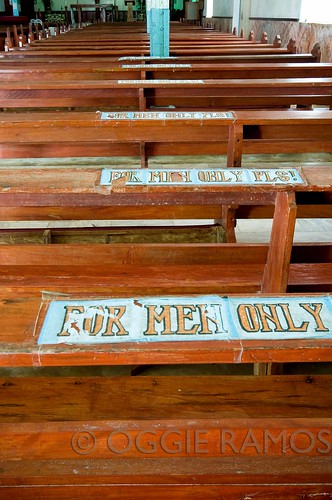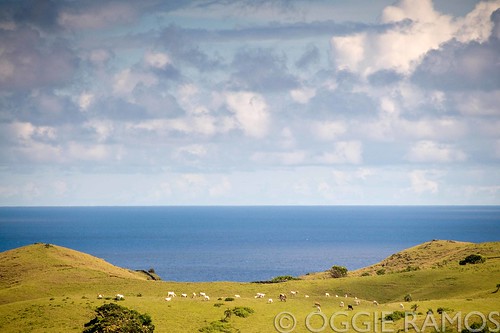 |
| Sta. Maria Church of Itbayat, built in 1888 |
Nanay Maria Gordo, the owner of a homestay on Itbayat, was so right about giving us each a mosquitero to go with the blankets. When the power on the island went off at 12, the mosquitoes were only too eager to oblige to a midnight feeding. We had a long chat with Nanay Tina Cano, Itbayat's tourism officer the night before. But not before visiting the striking Sta. Maria church. Fr. Dennis, the Spanish priest who has been here for 42 years, was preoccupied when we visited but after seeing me shooting on the grounds, he promptly sent one of the kids to open the church doors.
 |
| Back pews for men only |
The building of the church has an interesting backstory. In the 1800s, the Spaniards who saw the locals' adherence to the new faith sought their free labor. Thousands of locals lined up side-by-side the 1.7 or so kilometer distance between the town center and Pagganaman port where the stones were quarried.
We would've wanted to wander into the caves down south but it was wonderful to chat with Nanay Laura of Laurez Carinderia located just in front of the church. She's a kind lady and a retired municipal treasury officer turned cook and craftswoman who's seen a lifetime of changes on the island and it is always fascinating to hear stories from the locals themselves.
 |
| Clear sky, blue sea, green hills of Raele |
Seeing the beautiful lay of the land. Still, we've got time to spare for a look-see of Raele, one of the island's five barangays where the airport is being built. Construction has been ongoing for the past two years and many are waiting in great anticipation (I included) when it will finally open. This will greatly help bring in more visitors who are otherwise unable to visit as the 3-hour boat rides are not for the easily seasick.
After traversing tracts which are being reforested, we gape at the wide open expanse of green pastureland meeting the sea in a lot of places. The way Ironwulf described it is "Batan's Marlboro Hills -- only much, much bigger". I couldn't agree more. The place really looked and felt like a huge postcard come to life. At one point, in Tawran, one can see the peaks of D'inem, Riposed and Batan's Iraya side-by-side. Amazing, indeed.
 |
| Vernacular houses made from grass preceded the stone houses |
Jason, our guide, took us to the vernacular houses of Raele which are cogon grass houses that preceded the more familiar Ivatan stone houses (It was the Spaniards who introduced the concept of building houses with stone). Visiting one to shoot more details, we came across a boy and his father, the latter despite feeling that his house was unkempt for shooting, obliged. Before we left, he gave us a pasalubong of two pineapples. I forgot his name but I will never forget his kindness, nor of his kababayans.
